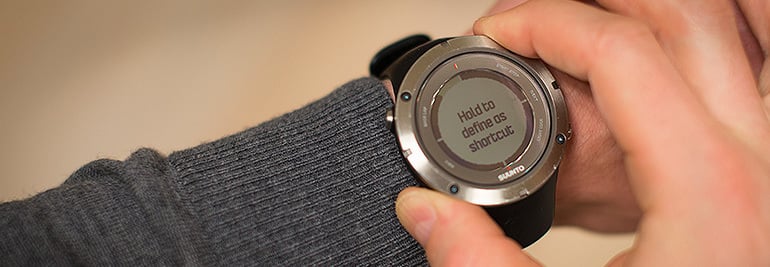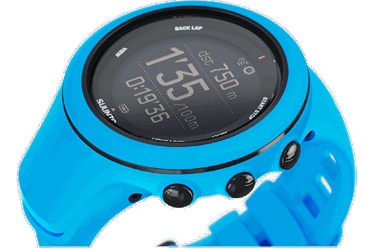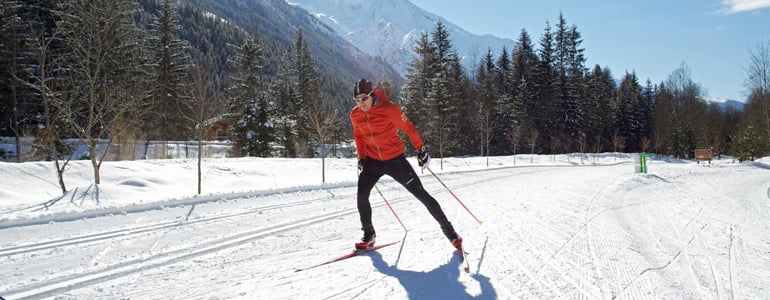

Suunto Blog

TUTORIAL TUESDAY: WHERE AM I? FINDING YOUR LOCATION WITH AN AMBIT
Figuring out where you are is fairly simple when you have a map, the visibility is good and you can identify a few landmarks. But when the going gets rough, the weather is against you and the sun sets, the task isn’t so simple any more. In this tutorial you will learn how your Ambit can help you to find your location.
The basics are simple: you can find your current position with a few clicks of the Ambit.
Choose: Navigation – Location – Current
To make sure you get the satellite fix as quickly as possible, remember to sync your Ambit regularly and keep it up to date.
Once you have found the GPS signal you will get your current location in geographic coordinates. The most common coordinate system in GPS devices is WGS84, which is also used by default in Suunto GPS watches.
Use the same coordinate system on your watch and map
If you need to give your exact location to someone in a rescue situation, WGS84 works. But when you start using a map and defining your location on it, you will need to make sure your GPS watch and the map use the same coordinate system. (To change your Ambit’s coordinate system go to General – Formats – Position format.)
Latitude/longitude is the coordinate system used in marine navigation and is common on topographical outdoor maps. Latitude lines run horizontally. The zero latitude is the Equator. Longitudes run vertically and the zero longitude runs through Greenwich, England. The latitude is normally the first number expressed in lat/long coordinate (for example 60°16'19" N 24°58’23’’ E).
WGS84, which uses latitudes/longitudes, is actually more than a coordinate system: it also includes a model of the globe that enables the use of GPS altimeters.
UTM is a grid coordinate system that is used on many outdoor maps. It divides the map into a perpendicular grid in which each of the squares are the same size anywhere on the map. This means the coordinate system is tied directly to a distance in meters.
This Norwegian map has both WGS84 (black) and UTM (blue) coordinates.
The black numbers on the sides of the map are degrees latitude; the numbers on the top and bottom of the map are degrees longitude. To determine your location on the map, draw a west to east line through the corresponding latitude and a south to north line through the corresponding longitude. The intersection of the two lines indicates your position.
The blue numbers are the northings and eastings of the UTM coordinate system. You can use them like the lat/log when finding your location on the map.
You can get support for your Suunto product at support

Coast to Coast: an iconic adventure race
Speight’s Coast to Coast is an iconic multisport race across New Zealand's South Island. Every year, more than 800 competitors line up to run, cycle and paddle the 243km width of the island. No one knows more about the event than 5-time winner and current race director, Richard Ussher. He explains its enduring appeal.
Why is the race so iconic?What really sets it apart is the concept of crossing a country in a day (or two). New Zealand’s South Island is the perfect distance – long enough to be a real challenge, yet short enough to be achievable by more than just the truly insane.
Is it more adventure-race or triathlon?I’d say it falls between the two. Top competitors certainly treat it more like a triathlon, where further down the field you probably get more into the adventure-racing realm.
Richard also created a Suunto Movie of the Coast to Coast Mountain Run course with his Suunto Ambit3, which you can see here.
Post by Richard Ussher.
Which discipline decides who wins?You really have to be an all-rounder to win. The two sections that tend to decide the race are the Mountain Run and the Kayak. But then there’s still 70km of cycling to finish it off – normally into a stiff headwind.
Did you record the Running Stage time yourself?Yes. It’s probably close to what the bulk of the better two-day runners will set. The top one-day and team competitors are closer to the 3-hour mark though. Last year’s winner Braden Currie clocked 2:49 for the run.
How did you become race director?The event was sold to a company called Trojan Holdings in 2013. They contacted many former participants and asked them where they thought the race needed to go. I was a little vocal in my opinions, and after talking with them, ended up in the role. It certainly wasn’t something I thought about before, but it’s a great opportunity.
So you’re retired?No, I’m not retired. I had a very tough 2014 because of injury, but I can finally see light at the end of that tunnel. My focus is obviously on the management side of Coast to Coast now, but I still love getting out and competing. Nowadays, I’m more focused on competing in races that I’ve always wanted to do.
How do you like the Suunto Movie Tell us about Suunto Movie on the Ambit?I really like this feature, especially where you get to see the whole course in the revolving view. I can see it being really useful for multisport athletes, as it gives you an idea of what the course might be like, and to a certain degree helps create a picture of the gradients involved.
Have you used Suunto products before?Yes, I’ve been using Suunto products from early on in my adventure-racing career – starting with the Suunto Advizor, which I still have. I also use the global compass range and orienteering compasses as well as Suunto’s Ambit and Core watches. Suunto products have always been fantastic.
Follow the race here: www.coasttocoast.co.nz
All pics ©sportzhub.com

Tutorial Tuesday: Customize your Ambit’s shortcut button
Do you have a favorite Ambit feature that you wish you could access quicker? No worries, in time mode you can access any menu item with a single push of a button after you have taught your Ambit2 or Ambit3 what you wish the shortcut button will do.
The shortcut button comes in handy in many ways. For example, it is a quick way to set the wake-up alarm and travellers can use the shortcut to easily set the dual time to match the destination’s time zone. And for your most frequent activity the shortcut button can lead straight to the right sport mode setting you ready to go with a single push of a button.
Here's how to use your Ambit's shortcut.
DEFINE A SHORTCUT
By default, when you keep [View] pressed in TIME mode, you toggle the display between light and dark. This shortcut can be changed to a different menu item.
To define a shortcut:
1. Keep [Next] pressed to enter the options menu or press [Start Stop] to enter the start menu.2. Browse to the menu item to which you want to create a shortcut. 3. Keep [View] pressed to create the shortcut.
Your own shortcut works when the watch is in time mode. In other modes, keeping [View] pressed accesses predefined shortcuts. For example, when the compass is active, you can access the compass settings by keeping [View] pressed.
NOTE: Shortcuts cannot be created to all possible menu items, such as individual logs.
You can get support for your Suunto product at support

Suunto Ambit3 Sport wins the Good Design Award
Suunto is proud to announce winning an award from Good Design for the Suunto Ambit3 Sport GPS watch. Good Design is the world’s longest-running, most prestigious and recognized design program. It is organized annually by The Chicago Athenaeum Museum of Architecture and Design in cooperation with the European Centre for Architecture, Art, Design and Urban Studies.
Good Design covers new consumer products and each year accepts several thousand submissions from manufacturers and industrial and graphic design firms from more than 48 countries. All award-winning products and graphic designs are published in Good Design’s yearbook for 2014-2015 and are listed on The Chicago Athenaeum Museum’s website.
“The Suunto Ambit3 Sport simplifies the appearance of our multisport watches. A sleeker and cleaner appearance makes no compromises on the demands of multisporters and triathletes. The new top ring opens up possibilities for bold color design, and the new silicone straps fit all wrists comfortably and improve ergonomics”, says Björn Bornemann, the Designer of the Ambit3 Sport. “This watch looks great on the track and confident in the office as well.”
Good Design chose the Suunto Ambit3 Sport GPS watch for its sleek design, advanced run, cycle and swim functions and its mobile connectivity. The Ambit3 Sport is fully designed and manufactured in Finland.
For more product details and specs, visit ambit3.

Head south for the perfect winter training camp
Winter may be here but that’s no reason to ease up on the training. Follow the example of the pros and migrate south for your warm weather fix. The only question is where to go. These five destinations should help you choose where to set your winter travel compass... Mallorca, SpainSmooth roads and long climbs – for many years, cyclists have been making the pilgrimage to the Mediterranean island of Mallorca and it's not difficult to see why. Just a two-hour flight from most of Europe. Mallorca’s terrain varies from flat coastal roads, to steep mountain passes. The longest climb on the island, the Puig Major, rises to 854m over the course of 14km. It's also the perfect photoshoot location, as these pics from our photoshoot below show.
Trail running in Mallorca on the Suunto photoshoot. ©zooom.at/Markus Berger
Tenerife, Canary IslandsBoasting the longest continuous climb in Europe – from sea level to 2,200m in one hit – Tenerife is the ideal place for those looking to improve their performance in the saddle. Offering dry and warm weather over the winter months, it's an ideal spot for migratory cyclists and triathletes. The island is also where the 2012 Tour de France winner Bradley Wiggins trained. But we can't promise it will put you in contention for the yellow jersey.
©Club La Santa, LanzaroteLanzarote, Canary IslandsThe favored destination of many a triathlete, Lanzarote is home to several training camps as well as one of the toughest Ironman events in the world. One of the reasons for its difficulty? Lanzarote is notorious for its wind, which has been known to destroy the spirit and soul of many a cyclist. Fortunately, the island is home to many world class Olympic pools, such as those at Club La Santa and superb trail running for when you want to recover from the bike. Stellenbosch, South AfricaIf you really want to escape winter, you need to head to the southern hemisphere. With its long open roads South Africa's wine growing region of Stellenbosch has been a favored pre-season training ground for many pros, including Jan Frodeno and Javier Gomez. Great riding in the mountains; top training facilities and pools in the University of Stellenbosch, and excellent wine of course.
Open water swimming in Mallorca. ©zooom.at/Markus Berger
San Diego, CaliforniaIt's no accident that San Diego is the birthplace of modern triathlon; the warm Pacific waters provide the perfect venue for open water swimming, trails abound for runners while inland you can find endless hills to crank out the miles in the saddle. Best of all, it has an average temperature of 21ºC and it's open all year round.

Cross training tips for cyclists
It may sound strange, but getting off the bike can help make you stronger, fitter and faster, as well as decrease your risk of injury. It’s a chance to develop muscles that get neglected while on the bike and address any weaknesses. Check out the suggestions below that will have you ready for your spring cycling.
1. Cross-country skiing Cross Country Skiing is the perfect cross-training sport for cyling. It uses the muscles in ranges of motion that are very similar to cycling, while giving your mind and muscles a much-needed break from pedaling. You’ll enhance strength in your hips, quads and abdomen – the key sources of power you use to drive the pedals, as well as give your heart and lungs a good workout.It's also great fun.
2. Work on your coreIf you've ever left spin class or a long ride with a sore back, a weak core is to blame. Cycling's tripod position, in which the saddle, pedals and handlebar support your weight, relies on core strength but doesn't build it. Try performing long sets of exercises like the plank and side plank—holding for up to three minutes.
Emelie Forsberg demonstrates the plank
3. Swimming Swimming is also a great way to improve your upper body strength and balance and can improve flexibility as well as offering some additional cardiovascular fitness. It forces you to use your upper body at a relatively low impact. Try to vary the strokes between front crawl, backstroke and breaststroke.
We recommend you swim indoors during winter! ©zooom.at/Markus Berger
4. Weight trainingDoing the same activity everyday can lead to imbalances in the body, and this can lead to injury. And your time on the bike needs more than just quad strength—your core, low back, triceps, and even your neck take a lot of strain from long bouts of pedaling. Weight training will increase both your cycling strength and efficiency. Try lunges, dumbbell squats, single-leg deadlift, swiss ball hamstring curls and bent over row with high reps and moderate resistance that develop muscular endurance.
4. Yoga and Pilates You’re more than likely tight, stiff or imbalanced from too-many months of cycling without other physical activity. Yoga and Pilates can do wonderful things for cyclists because they lengthen and strengthen a whole host of muscles. They also teach you how to activate and strengthen your core muscles.
Will Trubridge practises yoga for his freediving










































































